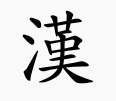The Japanese language was added a month ago to the supported languages of the Verbix verb conjugator. Currently Verbix allows users to enter the verbs to conjugate in letters of the English alphabet.
This is achieved by supporting romaji, i.e., writing the letters in Latin script. This is also called romanization.
There are several romanization systems, from which Verbix chose Hepburn romanization with minor modifications. Hepburn is the most common romanization system in use today, especially in the English-speaking world.
Read more:
- Japanese Verb Conjugator — conjugate Japanese verbs
- More information about Japanese verbs

